Related Research Articles
Detective Inspector John Rebus is the protagonist in the Inspector Rebus series of detective novels by the Scottish writer Sir Ian Rankin, ten of which have so far been televised as Rebus. The novels are mostly set in and around Edinburgh. Rebus has been portrayed by John Hannah and Ken Stott for Television, with Ron Donachie playing the character for the BBC Radio dramatisations.

Sherlock Holmes in the 22nd Century is an animated television series in which Sherlock Holmes is brought back to life in the 22nd century. The series is a co-production by DIC Entertainment, L.P. and Scottish Television Enterprises and was nominated for a Daytime Emmy for Special Class Animated Program.
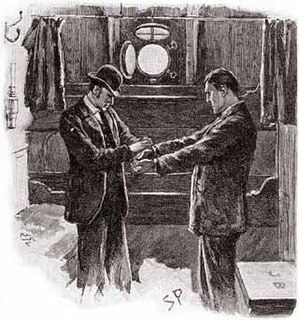
Detective Inspector G. Lestrade, or Mr. Lestrade, is a fictional character appearing in several of the Sherlock Holmes stories written by Arthur Conan Doyle. Lestrade's first appearance was in the first Sherlock Holmes story, the novel A Study in Scarlet, which was published in 1887. The last story in which he appears is the short story "The Adventure of the Three Garridebs", which was first published in 1924 and was included in the last collection of Sherlock Holmes stories by Doyle, The Case-Book of Sherlock Holmes.

The Face on the Cutting-Room Floor is a 1937 crime novel by Ernest Borneman writing as Cameron McCabe. It was first published in London. The book makes use of the false document technique: It pretends to be the true story of a 38-year-old Scotsman called Cameron McCabe who writes about a crucial period of his own life, during which several people close to him are murdered.
Hamish Macbeth is the lackadaisical police constable of the fictional Scottish Highland town of Lochdubh, in a series of murder mystery novels created by M. C. Beaton.

The Inspector Rebus books are a series of detective novels by the Scottish author Sir Ian Rankin. The novels, centred on Detective Inspector John Rebus, are mostly based in and around Edinburgh. They are considered an important contribution to 'Tartan Noir'.

Claud Eustace Teal is a fictional character who made many appearances in a series of novels, novellas and short stories by Leslie Charteris featuring The Saint, starting in 1929. A common spelling variation of his first name in reference works and websites is Claude, however in his works Charteris uses the spelling without the 'e'.

Charles Frederick Field was a British police officer with Scotland Yard and, following his retirement, a private detective. Field is perhaps best known as the basis for Inspector Bucket in Charles Dickens's novel Bleak House.
Charles Todd is a pen name used by the American authors Caroline Todd and Charles Todd, who were mother and son. Caroline Todd was the pen name for Carolyn Watjen and Charles Todd is the pen name for her son David Watjen. Caroline Todd died on August 28, 2021, at age 86 from complications of a lung infection. Charles Todd lives in North Carolina.
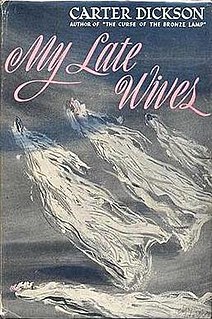
My Late Wives is a mystery novel by the American writer John Dickson Carr, who published it under the name of Carter Dickson. It is a whodunnit featuring the series detective Sir Henry Merrivale and his long-time associate, Scotland Yard's Chief Inspector Humphrey Masters.

Artists in Crime is a detective novel by Ngaio Marsh; it is the sixth novel to feature Roderick Alleyn, and was first published in 1938. The plot concerns the murder of an artists' model; Alleyn's love interest Agatha Troy is introduced.
This article describes minor characters from the Sherlock Holmes stories by Sir Arthur Conan Doyle, and from non-canonical derived works. The list excludes the titular character as well as Dr. Watson, Professor Moriarty, Inspector Lestrade, Mycroft Holmes, Mrs. Hudson, Irene Adler, Colonel Moran, the Baker Street Irregulars, and characters not significant enough to mention.
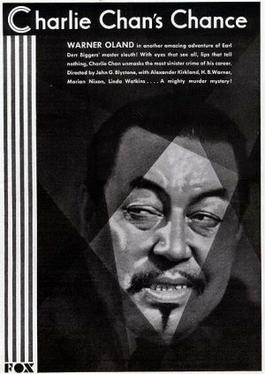
Charlie Chan's Chance is a 1932 American pre-Code murder mystery film, the third to star Warner Oland as detective Charlie Chan. It is based on the 1928 novel Behind That Curtain by Earl Derr Biggers, who also contributed to the film. The film is considered to be lost.
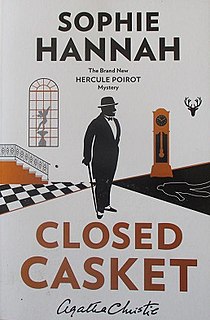
Closed Casket is a work of detective fiction by British writer Sophie Hannah, featuring Agatha Christie's Hercule Poirot. Hannah is the first author to have been authorised by the Christie estate to write new stories for her characters. Hannah's work closely resembles the Golden Age of Detective Fiction in its structure and tropes. Closed Casket even includes a plan of the house in which the murder takes place; such plans were sometimes used in Golden Age novels to aid the reader in their solving of the mystery puzzle.

The Railway Viaduct is the third title in the Railway Detective series of detective mystery novels written by Keith Miles under the pseudonym Edward Marston. Set in 1852, it is about a murder on a train which is investigated and ultimately solved by two Scotland Yard detectives, Inspector Robert Colbeck and Sergeant Victor Leeming. The title place is the Sankey Viaduct on the former Liverpool and Manchester Railway. The novel was published in 2006 by Allison & Busby of London. The graphic on the book cover is from T. T. Bury's 1831 depiction called Viaduct across the Sankey Valley in his Liverpool and Manchester Railway series of paintings. According to the publishers in a 2018 news release, the series has been optioned for television adaptation by Mammoth Screen.
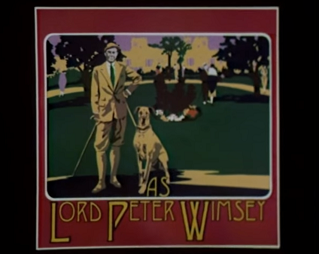
Lord Peter Wimsey is a series of television serial adaptations of five Lord Peter Wimsey novels by Dorothy L. Sayers starring Ian Carmichael broadcast on BBC One between 1972 and 1975, beginning with Clouds of Witness in April 1972.

The Sea Mystery is a 1928 detective novel by Freeman Wills Crofts. It is the fourth in a series of novels featuring Inspector French of Scotland Yard. As with a number of his works Crofts creates a puzzling mystery which French is then able to solve using a Tide table and Bradshaw's Guide to the railways. The plot has some similarities with his debut novel The Cask (1920).
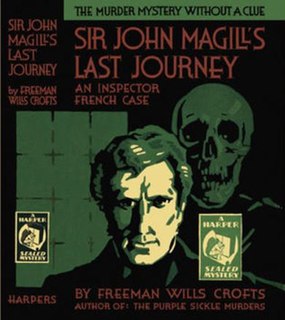
Sir John Magill’s Last Journey is a 1930 detective novel by the Irish writer Freeman Wills Crofts. It is the sixth in his series of novels featuring Inspector French, a prominent figure of the Golden Age of Detective Fiction. Much of the novel takes place in Northern Ireland, particularly around Belfast, where Crofts had spent a great deal of his younger years before moving to England. As with many of his puzzle mysteries its solution revolves around railway timetables as well as the possible distance a boat could cover in a certain time.

Poison for One is a 1934 detective novel by John Rhode, the pen name of the British writer Cecil Street. It is the eighteenth in his long-running series of novels featuring Lancelot Priestley, a Golden Age armchair detective. It combines elements of the locked room mystery and country house mystery. Reviewing the book in the Sunday Times leading crime writer Dorothy L. Sayers considered it "as usual, sound, pleasantly written, and entertaining" although she complained the book "was rather spoilt for me by the jacket, which deliberately gives away one-half of the solution."
References
- ↑ "Charles Todd. Timeline." . Retrieved 5 July 2013.
| Title | Publication year | Book year |
|---|---|---|
| A Test of Wills | 1996 | 1919/6 |
| Wings of Fire | 1998 | 1919/7 |
| Search the Dark | 1998 | 1919/8 |
| Legacy of the Dead | 2000 | 1919/9 |
| Watchers of Time | 2001 | 1919/10 |
| A Fearsome Doubt | 2002 | 1919/11 |
| A Cold Treachery | 2005 | 1919/12 |
| A Long Shadow | 2006 | 1920/1 |
| A False Mirror | 2007 | 1920/3 |
| A Pale Horse | 2008 | 1920/4 |
| A Matter of Justice | 2009 | 1920/5 |
| The Red Door | 2010 | 1920/6 |
| The Kidnapping | 2010 | 1920 |
| A Lonely Death | 2011 | 1920/7 |
| The Confession | 2011 | 1920/8 |
| Proof of Guilt | 2013 | 1920/9 |
| Hunting Shadows | 2013 | 1920/8 |
| A Fine Summer's Day | 2015 | 1914/6 |
| No Shred of Evidence | 2016 | 1920/10 |
| Racing the Devil | 2017 | 1920/11 |
| The Piper | 2017 | 1914/3 |
| The Gate Keeper | 2018 | 1920/12 |
| The Black Ascot | 2019 | 1910/1920 |
| A Divided Loyalty | 2020 | 1921/2 |
| A Fatal Lie | 2021 | 1921 |
| A Game of Fear | 2022 | 1921 |
- ↑ "Charles Todd » The Books". www.charlestodd.com. Archived from the original on 26 December 2007.